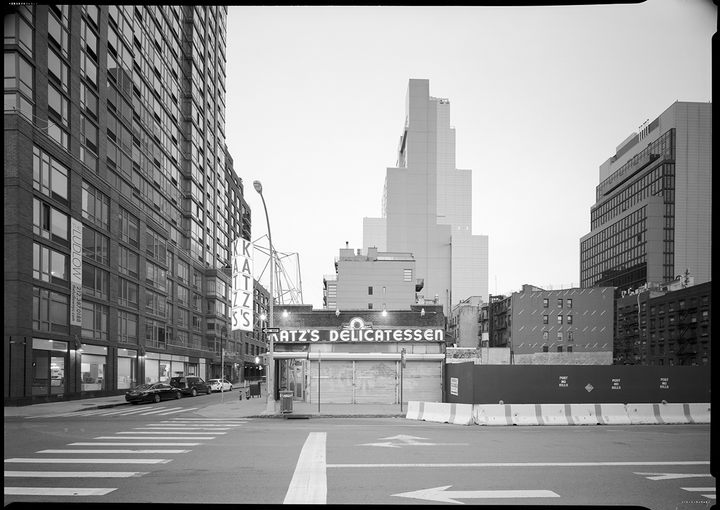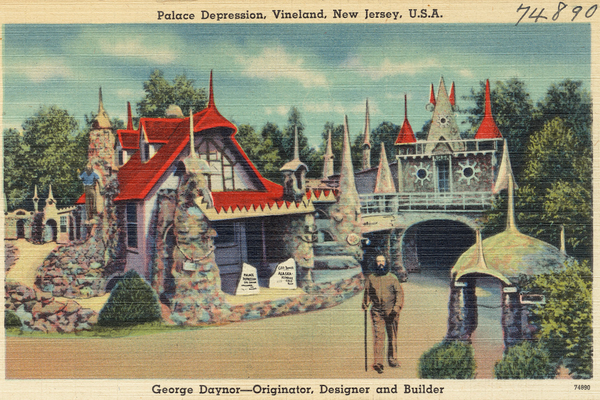
Picturing Manhattan’s Shortest Buildings From the Ground Floor
A photographer set out to document single-story buildings—the anti-skyscrapers.
Adam Friedberg hit the streets early, when the sidewalks were as empty as they’d ever be, when street lights still threw an amber glow, when the city’s low-slung buildings were still tucked to sleep behind dingy metal grates.
Starting in 2015, Friedberg, a photographer living and working in New York City’s East Village, roamed a lopsided rectangle that had him zigzagging through the Village and the Lower East Side. His route was bounded by 14th Street to the north, Avenue D to the east, Canal Street to the south, and Broadway to the west. He crisscrossed the map over and over again, in search of single-story buildings. To date, he has photographed 100 of them, from storefront churches to garages, warehouses, and bars. Fifty-four of his large-format, black-and-white images will be on view at the Center for Architecture beginning November 21.
Friedberg considers himself an environmental photographer, and says his interest in photographing architecture boils down to a fascination with order and where it splinters into disorder. He suspects that this curiosity took root after a disorienting spell of vertigo that had him laid up for days in the mid-’90s. Focusing on level shapes, he says, “made me feel like things weren’t about to be spinning.”

Vertigo is also an apt metaphor for the feeling of New York City. Stay long enough, locals often say, and reliable landmarks will start to disappear, as rents rise and higher buildings spring up. Friedberg recalls noticing the disconnect between one-story buildings and newer, higher, sleeker ones while wandering near Astor Place. He noticed that tall, glass buildings were soaring above a flatter strip that held a McDonald’s, a bar, and a smoke shop. “It looked like the skyline got punched, and there’s a broken tooth right there,” Friedberg says.
Friedberg had been living in the area for nearly three decades, but he hadn’t paid much attention to his shortest brick-and-mortar neighbors. That’s partly because he didn’t find the single-story buildings especially eye-grabbing; they tend to be plain and box-like, he says, barely ornamented except with an old sign here and there. But he remembers thinking to himself, “Look, there’s a 20-story building next to this warehouse that’s starting to fall apart.” He was intrigued by the way the old and new sat next to each other.
In the absence of an index of the squattest buildings in his neighborhood, Friedberg relied on shoe-leather sleuthing, with help from maps and Google Street View. He knows he may have missed some, and they might be gone before he stumbles across them; a few buildings that he intended to photograph, including two gas stations, were demolished and replaced with condos before he got the chance. Others have disappeared since he recorded them.

Friedberg aimed to produce images free from hard shadows, people, and cars, to limit any visual distractions and put the buildings front and center. He also captured as much of the surroundings as he could manage, he says, “photographing the existing and having the new come in in the margins to show the discrepancy between the two.” One image of Katz’s Delicatessen, on Houston Street in Lower Manhattan, showcases a construction site on one side and a towering, glinting luxury apartment building on the other.
In many corners of the city, developers are building higher and higher; Central Park is now fringed with vertiginous “pencil towers,” spectacularly tall, surprisingly skinny buildings, such as the 88-floor residential skyscraper 432 Park Avenue. In New York City, height has always mattered: People have fretted over skyscrapers for over a century. “The city’s first zoning code was enacted as New Yorkers began to worry that tall buildings would cast the city into eternal darkness,” the New York Times reported in 2016. When Equitable Building went up at 120 Broadway in 1915, reaching more than three dozen stories tall on the site of an earlier, shorter skyscraper destroyed in a fire, it reportedly threw a seven-acre shadow across its environs. All these years later, the Times has mapped the shadows that the city’s buildings fling.

In the midst of all this change, some residents protest the disappearance of local businesses by inveighing against gentrification and celebrating the places that manage to hold on. The idea that the city’s character is diminished as chain stores expand is a central tenet of Vanishing New York: How a Great City Lost Its Soul, by Jeremiah Moss, a book that’s part ode, part call to arms. Over the years, many small businesses and holdouts have given way to national chains like Starbucks, Dunkin’ Donuts, Walgreens, and MetroPCS—though in 2018, national chains lost ground in New York for the first time in a decade, according to a report produced by the Center for an Urban Future.

Change has always been a part of the East Village, writes journalist Ada Calhoun in St. Marks Is Dead: The Many Lives of America’s Hippest Street, a cultural history of one of the East Village’s central arteries. Manhattan was once home to the Lenape people, who were forcibly removed by the Dutch. Over several centuries, what is now St. Marks became farmland cultivated by Dutch settlers, a neighborhood full of heavy-pocketed merchants and statesmen, the territory of bootleggers, and a home base for working-class Polish, Italian, and Puerto Rican immigrants. It was a haunt for beatniks, then hippies, then punks. Each wave of arrivals complained that the soul of the neighborhood had shriveled, even as it rebloomed as something new. “Every cohort’s arrival, the flowering of its utopia, killed someone else’s,” Calhoun writes.
To Friedberg, the series of photographs isn’t a critique, lament, or elegy. He isn’t set on preserving the architecture. “I’m not against developers tearing down these buildings,” he says. After all, he says, there was a time when the single-story buildings weren’t there—and maybe something else was torn down to accommodate them, or else a vacant lot was filled in. His approach is more documentarian than rabble-rousing: He set out to assemble a record of the neighborhood’s buildings, and the changes happening up and down its blocks. “How is it changing right now?” Friedberg asks. “And is this the right way to change things?”
You can join the conversation about this and other stories in the Atlas Obscura Community Forums.


















Follow us on Twitter to get the latest on the world's hidden wonders.
Like us on Facebook to get the latest on the world's hidden wonders.
Follow us on Twitter Like us on Facebook